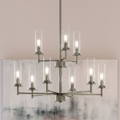The New-Traditional Design Style
The New-Traditional design style in residential interior design marries the elegance of classic, traditional motifs with a fresh, modern twist. It's a harmonious blend of the past's opulence and the contemporary's simplicity. This style celebrates the ornate woodwork, plush fabrics, and intricate patterns typical of traditional design, but it introduces them in a more streamlined, updated manner, ensuring the space feels current yet timeless. At its core, New-Traditionalism is about balance. As such, furniture pieces might retain their classic silhouettes but be upholstered in updated fabrics or neutral tones. Rich velvets and silks could be paired with modern textiles to prevent the space from feeling overly formal. While the traditional color palette of deep reds, greens, and blues can still be found, they are often muted or paired with brighter, lighter shades. Patterns, too, are essential. Think classic damasks or florals juxtaposed with geometric prints.
Ultimately, the New-Traditional design offers homeowners the comfort of the familiar, evoking nostalgia, while ensuring their spaces feel updated, sophisticated, and perfectly in tune with today's design sensibilities.

New-Traditional Style Architecture
Rooted in classical principles, buildings often feature symmetrical facades, pitched roofs, and ornate moldings. However, these traditional elements are reinterpreted, simplified, or combined in innovative ways, giving buildings a contemporary edge. Large windows and open floor plans are introduced, maximizing natural light and fostering a sense of spaciousness. Materials are a blend of the time-honored, like brick or stone, with modern alternatives.
Symmetrical facades are a nod to classical design principles.
Pitched roofs and ornate moldings maintain historical charm.
Modern touches include large windows and open floor plans.
A mix of traditional materials like brick is paired with contemporary alternatives.
The overall design seamlessly blends historic reverence with modern sensibility.

New-Traditional Style Materials
Hardwoods, cherished for their durability and rich tones, are often juxtaposed with sleek metals or glass. Natural marble and granite maintain prestigious status but may be presented in less ornate, more minimalist cuts. Traditional fabrics, such as velvet or brocade, are harmoniously paired with the more modern linen and cotton. Decorative elements could introduce ceramics or hand-blown glass, balancing the old-world craft with contemporary artistry.
Hardwoods are frequently paired with contemporary metals and glass.
Natural stones like marble are utilized in minimalist, modern cuts.
Velvets and brocades are harmonized with modern textiles like linen.
Ceramics and hand-blown glass merge old-world craftsmanship with modern design.
The material palette ensures spaces evoke both historical charm and contemporary elegance.

New-Traditional Style Colors and Finishes
New-Traditional designs employ a sophisticated palette of classic interiors with muted, neutral tones. Colors like navy, forest green, and burgundy might be softened with taupe, gray, or cream, creating a balanced look. Gold and brass finishes, reminiscent of classic opulence, are often refreshed with matte or brushed treatments. Woods might retain their natural grain or be painted in muted tones. Wallpaper and textiles can introduce patterns, but with a subdued color story or modernized design.
Classic hues like navy and burgundy are paired with neutrals like taupe.
Gold and brass elements often feature matte or brushed finishes.
Woods showcase natural grain or are painted in contemporary muted tones.
Wallpaper patterns are modernized and often rendered in subdued colors.
The overall color palette and finishes exude both tradition and modern sophistication.

New-Traditional Style Furniture and Decor
Furnishings often maintain their classic silhouettes, such as rolled arms on sofas or clawfoot tables, but are streamlined for a modern interpretation. The upholstery is a blend of luxe fabrics like velvet with practical choices like cotton or linen. Decorative accents play a pivotal role: vintage mirrors, classic artworks, and ornate vases are curated alongside contemporary pieces. Rugs often showcase traditional patterns but in refreshed color palettes.
Furnishings honor classic silhouettes but are modernized in form.
Upholstery mixes luxe and practical fabrics for comfort and style.
Decor merges vintage pieces with contemporary accents.
Rugs feature traditional patterns in updated color palettes.
The overall aesthetic is a seamless blend of historical charm and modern comfort.

New-Traditional Style Lighting
In New-Traditional designs, lighting fixtures serve as focal points that exemplify the style's fusion of past and present. Chandeliers, which might once have been heavily ornate, are reimagined with cleaner lines, yet still maintain their grandeur. Wall sconces with classic designs might feature contemporary materials or finishes. Table lamps combine traditional bases, like ceramic or brass, with updated shades. Pendant lights might nod to vintage styles but are streamlined for a current look.
Chandeliers are redesigned with cleaner lines but retain their traditional grandeur.
Wall sconces blend classic motifs with modern finishes.
Table lamps merge traditional bases with contemporary shades.
Pendant lights offer a nod to vintage forms yet are modernized in design.
Overall, lighting seeks to harmonize the historical with the contemporary.
